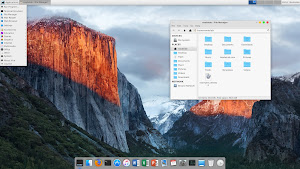For any Mac, I would always recommend using the most recent version of Ubuntu that is available since as time passes, more fixes for Mac nuisances are incorporated into the releases.


Kubuntu is an operating system built by a friendly worldwide team of expert developers. It contains all the applications you need, including a web browser, office suite, media apps, instant messaging, in addition to many others. For a list of the included software, see the Software page. Insert your USB stick in your Mac. Restart your Mac and hold down the Option Key while it reboots. When you arrive at the Boot Selection screen, choose 'EFI Boot' to select your bootable USB Stick. Select Install Ubuntu from the Grub boot screen. I'm also working (very slowly) on my move away from the Mac. I prefer OpenBSD and Illumos as operating systems, or even Alpine Linux (yay for systemd-free), but I will be going with Ubuntu as my desktop OS because it has better hardware support and software compatibility (e.g. Vivaldi browser or Docker), specially on laptops.
Ubuntu For Mac Iso
With Ubuntu 16.04 LTS inching ever closer to release, now feels like a good time to recap how easy it is to make an bootable Ubuntu USB drive.
Just like the live CD, a live Linux USB allows you to boot Ubuntu on your machine without needing to install it on your hard-drive. Live images are a useful way to test hardware compatibility (things like Wi-Fi drivers, touch-screens, etc) before committing to a full install.
In this article we show you 3 ways of making a bootable thumb drive on the 3 major desktop operating systems: Windows, OS X and Ubuntu.
How to Create a Bootable Linux USB Drive on Windows
Our preferred tool for creating bootable Ubuntu sticks in Windows is ‘Linux Live USB Creator' – often called ‘Lili' for short.
The free and open-source app is incredibly straightforward to use. Just follow each step in turn. It'll even download the .iso file for you if you don't have one to hand.
If you don't like this app (or can't get it run) there are alternatives, including Rufus (Github link)
Ubuntu For Mac G3
How to Create a Bootable Linux USB Drive on Mac OS X
For an OS that's prized for its simplicity it's strange that creating a bootable USB on a Mac is not easy.
But it's not impossible, either.
Canonical recommend a command-line method to create a bootable USB with Ubuntu on Mac O SX. The instructions are concise though the process is involved.
For something less longwinded you could give the open-source, cross-platform UNetBootin app a go.
It has to be said that while the success rate of images created using this app is poor (you can't use the USB's it creates to boot a Mac, for instance) it is the ‘easiest' way to create a bootable Ubuntu USB on Mac OS X. Mac really me.
Like LiLi above, Unetbootin can even automatically download a Linux distro .iso file, which is handy if you feel the itch to distro hop but don't know exactly which flavor to try.
Ubuntu Format Disk
Remember that to boot from a USB on a Mac you will need to hold down the Alt/Option' key during boot.
Other GUI alternatives include
How to Make a Bootable Linux USB Drive on Ubuntu
Ubuntu comes with an app to create live USB drives already installed.
Open the Dash and search for ‘USB Startup'.
Launch the app, locate your .iso file, choose your USB drive (double check it's the correct one!) and then hit ‘install'.
You can also configure persistence though I've never had a USB boot when I've enabled this feature.
What's your preferred method for creating bootable Linux USB drives? Let us know in the comments!
Introduction
psql is the standard command line interface for interacting with a PostgreSQL or TimescaleDB instance. Here we explain how to install psql on various platforms.
Before you start
Before you start, you should confirm that you don't already have psql installed. In fact, if you've ever installed Postgres or TimescaleDB before, you likely already have psql installed.
Install on MacOS using Homebrew
First, install the Brew Package Manager
Second, update brew. From your command line, run the following commands:
Finally, symlink psql (and other libpq tools) into /usr/local/bin: Mac parallel desktop windows 7.
Install on Ubuntu 16.04,18.04 and Debian 9,10
Install on Ubuntu and Debian using the apt package manager:
Note: That this only installs the psql client and not the PostgreSQL database.
Install Windows 10
We recommend using the installer from PostgreSQL.org.
Last step: Connect to your PostgreSQL server
Let's confirm that psql is installed:
Now, in order to connect to your PostgreSQL server, we'll need the following connection params: Mac pro 3 1 mojave.
- Hostname
- Port
- Username
- Password
- Database name
There are two ways to use these params.
Option 1:
Once you run that command, the prompt will ask you for your password. (Which we specified with the -W flag.)
Option 2:
Congrats! Now you have connected via psql.